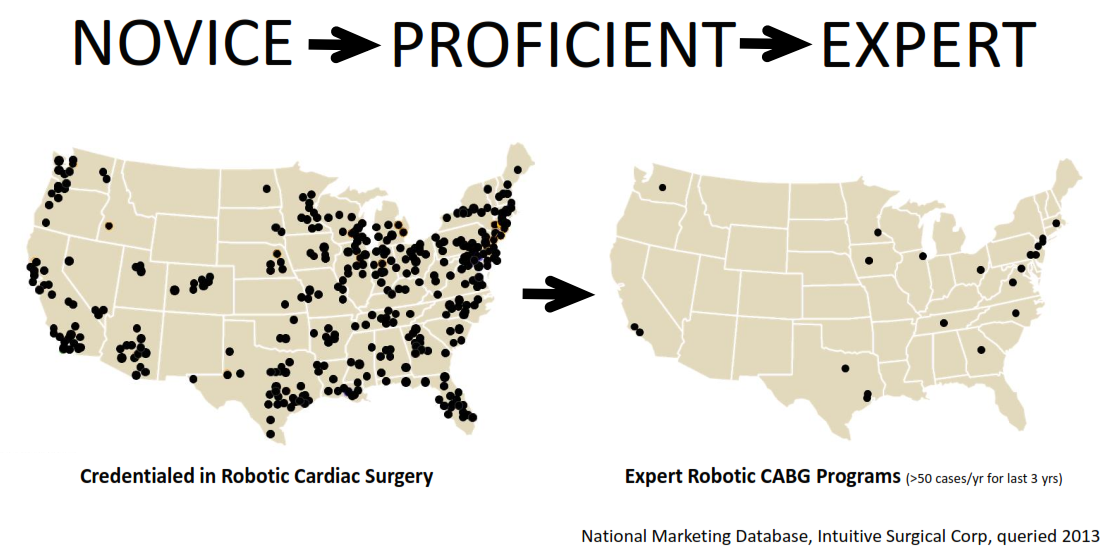What is Robotic Heart Surgery?
Welcome and thank you for visiting this website. The goal of this site is to provide patients and other interested parties with reliable information about less invasive and robotic-assisted cardiac surgery. Robotics is a state of the art surgical tool used by heart surgeons to be able to be able to perform intricate surgical procedures with far less trauma than the large chest incisions of standard methods. Surgeons are able to perform less invasive surgery without a robot and still provide many of the same advantages. Debates about costs, technical feasibility and safety of doing less invasive surgery using one technique vs. the other are not a topic that most patients and their families are concerned about as they worry about an upcoming heart surgery. This website will not address this issue. The essays, opinions and other descriptions provided on this site often use the term robotics because we feel it signals a surgical program committed to the most advanced techniques available.
This website aims to empower patients and their families with information. The history of less invasive procedures in surgical specialties other than heart surgery involved patients learning about these options through “word of mouth” and media coverage. This led patients to demand that surgeons provide it. Patient demand was the main thing that drove surgeons to adopt these techniques. For a variety of reasons that Dr. Poston discusses in his blog The Scandal of Robotic Heart Surgery Training and What to Do About It”, this same sequence of events has not prompted the adoption of less invasiveness in heart surgery. Patients that I’ve met don’t care about the details of their incisions, but are very interested in reducing their pain, recovery time and trauma.
All heart surgeons as professionals feel obliged to improve the procedures they offer, but the sternal split has become an established procedure that is difficult to improve upon. This procedure may not benefit those patients who have a condition where less invasiveness would be preferred such as those patients that require a mitral valve repair or one or two coronary artery bypass grafts. Surgeons choose options that they’ve been trained to perform, but patients often choose options by the motto: “If a less invasive approach gets the same outcome as an open surgery, then less invasive wins.”
The site contains a collection of videos of robotic heart surgery procedures. Some of the images may be a bit graphic, for example there are some views of a beating heart in surrounding blood. The videos have been included to demonstrate how surgical procedures are done less invasively with robotics. I have not included a video of the traditional procedure called a median sternotomy. Much more graphic by comparison, the chest is opened wide enough for the surgeon and 1 or 2 assistants to place their hands directly on the heart. This is a safe approach in most patients but adds some risk of bleeding and infection
Less invasive and robotic methods avoid the sternotomy, which improves outcomes by reducing the risk of some complications and makes recovery quicker. Access to the inside of the chest is gained not by making a wide opening in the chest. Instead, surgical instruments are placed in between spaces in the ribs. The surgeon controls the tips of the robotic instruments using a console that looks similar to a video arcade. The robot makes no actions that are independent of the surgeon. Montefiore hospital published in 2009 that many patients make the mistake of thinking that the robot itself performs the surgery, like how robots build cars on a Detroit assembly line. (http://www.ncbi.nlm.nih.gov/pubmed/22437226.)
The reality is far less exciting. The main value of the surgical robot is to provide surgeons with tools that work in cramped spaces in the chest and provide better dexterity, tremor control and visualization than possible using hand-held instruments.
Controlling instruments using a video console comes naturally to surgeons from the younger generation that grew up surrounded by video games and computers. In contrast, many surgeons (often the older ones) struggle to accept that a computerized robot could improve the technical capabilities above what is possible with direct human vision and manual dexterity. A surgeon’s ability to control the robot is a small portion of what leads to a successful outcome after robotic cardiac surgery. There is a whole team that needs to be developed. At a national surgical society meeting in 2015, Dr. Poston describes the reasons why it has been so rare for robotic cardiac surgery programs to succeed and persist through the long journey required to gain true expert status in this procedure.
A good decision doesn’t always require you to follow your doctor’s advice. The best way to define a good decision is one that avoids having regrets afterwards. Everyone wants to make a good decision about something as important as heart surgery and no one wants regrets about their health. They best way to avoid regret is to do what you are currently doing as you read this website and become fully informed about your options. Dr. Poston describes why the burden to ask questions and seek out information is often unfairly shifted onto patients in his blog Sometimes a Second Opinion is Best to Discuss Alternatives. A frequent question that patients have is why they were not told about robotics when they met with their heart surgeon. This question is addressed in the FAQ section.
Sometimes the only way to be fully informed about all your heart surgery options is to do your own research and take the initiative to obtain a second opinion on your own. If you or a family member is interested in a second opinion about your heart problem, you can contact Dr. Poston on his cell phone 7 days a week at 617-610-0126 or via email at [email protected].
You can also attend a support group meeting that meets monthly and discuss the surgical experiences of other past patients of Dr. Poston
We look forward to talking with you.


